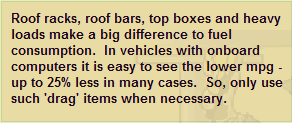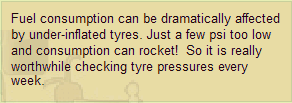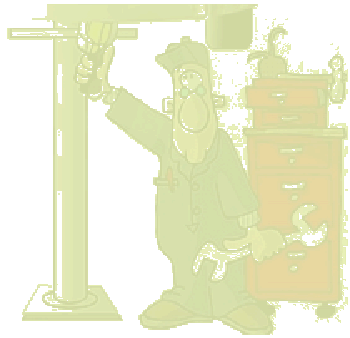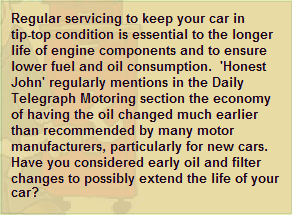If you want to see larger or smaller text,
press Ctrl & +/- keys,
or Ctrl & mousewheel.





Derek's Tips

Derek Osgood Limited
- Good Tips!
- Good Tips!


Roof racks, roof bars, top boxes and heavy loads make a big difference to fuel consumption. In vehicles with onboard computers it is easy to see the lower mpg - up to 25% less in many cases. So, only use such 'drag' items when necessary.
Fuel consumption can be dramatically affected by under-inflated tyres. Just a few psi too low and consumption can rocket! So it is really worthwhile checking tyre pressures every week.



Take your foot off the accelerator a little earlier when slowing for roundabouts and junctions etc ... it can make a big difference to fuel consumption.
Regular servicing to keep your car in tip-top condition is essential to the longer life of engine components and to ensure lower fuel and oil consumption. 'Honest John' regularly mentions in the Daily Telegraph Motoring section the economy of having the oil changed much earlier than recommended by many motor manufacturers, particularly for new cars. Have you considered early oil and filter changes to possibly extend the life of your car?
Opening hours:
8am - 5pm
Mon - Fri
8am - 5pm
Mon - Fri
Driving in Snow & Ice
Firstly, your vehicle needs to be in good condition.
- Make sure you have a winter check carried out by us before the cold weather starts each year. We often have a special offer.
- Keep your tyres at the right pressure - though in some circumstances it can be beneficial to reduce the normal pressures slightly to get better grip. So a foot-pump is handy to re-inflate.
- Tyres are much better in snow if you have plenty of tread. A minimum of 3mm is usually recommended - though some people, particularly in rural areas, use special winter tyres with rather more tread.
- Make sure you have the right mix of screenwash for below zero temeratures.
- Take great care when using your washer/wipers on a journey. If the nozzles are frozen no screenwash will hit the windscreen and your wipers will just spread any muck and may make it impossible to see ahead especially if there is a bright, low sun.
- Batteries can take quite a pounding in cold weather as fans, heated screens, heated seats etc are on more often. A long journey will help recharge the battery or you may need to use a charger especially if you only make short journeys.
- Regularly spray your door locks with WD40 or similar. Just put the long 'nozzle' on, insert just past the key cover, then squirt for a second. This should keep them free of 'freezing'.
- If you find that your brakes are frozen 'locked' ... engage reverse and try to move gently backwards to free them.
When driving in snow and ice it is essential to be far more careful and use a different 'style'.
- Pulling away can be tricky, especially on uphill slopes. Use the minimum of revs. With modern cars you can often keep your foot OFF the accelerator. Just gently engage the clutch and ease the hand-brake off and you may get sufficient traction to start moving. It is no good revving your engine as the tyres will not grip and will spin.
- On the old rear-wheel drive vehicles, we used to engage the handbrake, rev very gently and slowly disengage the hand-brake to gain traction.
- Sometimes it can help to use 2nd gear rather than first to pull away.
- Keep revs low (use a low gear) where possible, to avoid wheel spin.
- Do not use the foot-brake as you normally would. Think ahead, change gear earlier than usual and gently ease in the clutch. In many cases (even when going downhill) you will find that you can stop or almost stop without using the foot-brake.
- Do not follow vehicles too closely, especially when going downhill. If necessary ease off the accelerator to create a bigger space.
- Side roads are often untreated, whereas main roads and bus routes may be gritted and salted. However, there is no guarantee that every square metre of a 'gritted' road has been covered. So still take extra care and maintain extra distance.
- It is 'hard' movements that cause many accidents/problems in ice and snow. Avoid hard braking, entering bends at speed etc. Keep everything 'smooth'.
- Some people cause problems for themselves and others by assuming that they 'must' drive slowly in snow and ice. But to get up hills the right speed is necessary.
- If you start to skid the natural reaction is to want to brake ... but you need to avoid doing so. ABS may not respond normally in ice and snow.
- Cat litter - Sainsbury's own brand ('Basics') for example. Cheap and very effective if you cannot get any traction.
- A spade or shovel to help dig you out of trouble.
- Mobile phone - fully charged.
- Food and drink, preferably hot, like a good soup.
- Adequate clothing, gloves etc and wellies/boots.
- Blankets.
- Hi-viz vests/jackets.
- Torches.
- A hi-viz 'flag' particularly if travelling across country, just in case you get stuck and need to display it to get help. Make sure you regularly shake it to clear any falling snow.
- In windy conditions snow can be blown into huge snowdrifts, making journeys impossible. Fortunately, the recent snow in Hampshire (2010) has not blown into deep drifts. But always watch the forecasts and the expected wind speeds to be prepared for drifts. Many exposed roads, subject to drifting have special close-knitting fences erected some metres back from the road, to try to prevent huge drifts.
- Always make sure your entire car is clear of snow and ice before setting out. Not to do so is both dangerous for you and others. It may also be illegal if you cannot see properly, or you allow snow on your vehicle to blow off and impede other motorists. Not having your registration number visible, lights and indicators clear, could also be an offence. All you need is a good ice-scraper .... and a soft broom. It only takes a few minutes to completely clear a car.
- Do not use hot water to clear a windscreen .... it may crack it. Plus, that water may well have frozen on the ground when you return home .... which could cause problems for you.
- Carry a plastic drinks bottle (clearly labelled) with a screenwash mix in it. If your windscreen sprayers become frozen, you can always stop somewhere safe and use the 'solution' to provide a 'solution' .... and clear your screen.
- The recommended advice is to stay with your vehicle - though that may depend upon your situation/location. If there is no nearby help that you have noticed (an open pub or houses with lights on) then staying with the vehicle and keeping warm and well-fed may be the best solution.
- The emergency services will be looking for those who are stuck ... and with your mobile phone you can call them and their systems will trace your phone's location, so they can pinpoint you.
- Take care if you keep the engine running for a while .... a snow blockage of the exhaust could lead to carbon-monoxide poisoning.
- Do not run your engine for too long - perhaps 10-15 minutes per hour is safest.
Please do stay safe in the snow.
Derek Osgood Limited
(more than just a great service)

Derek's Tips
